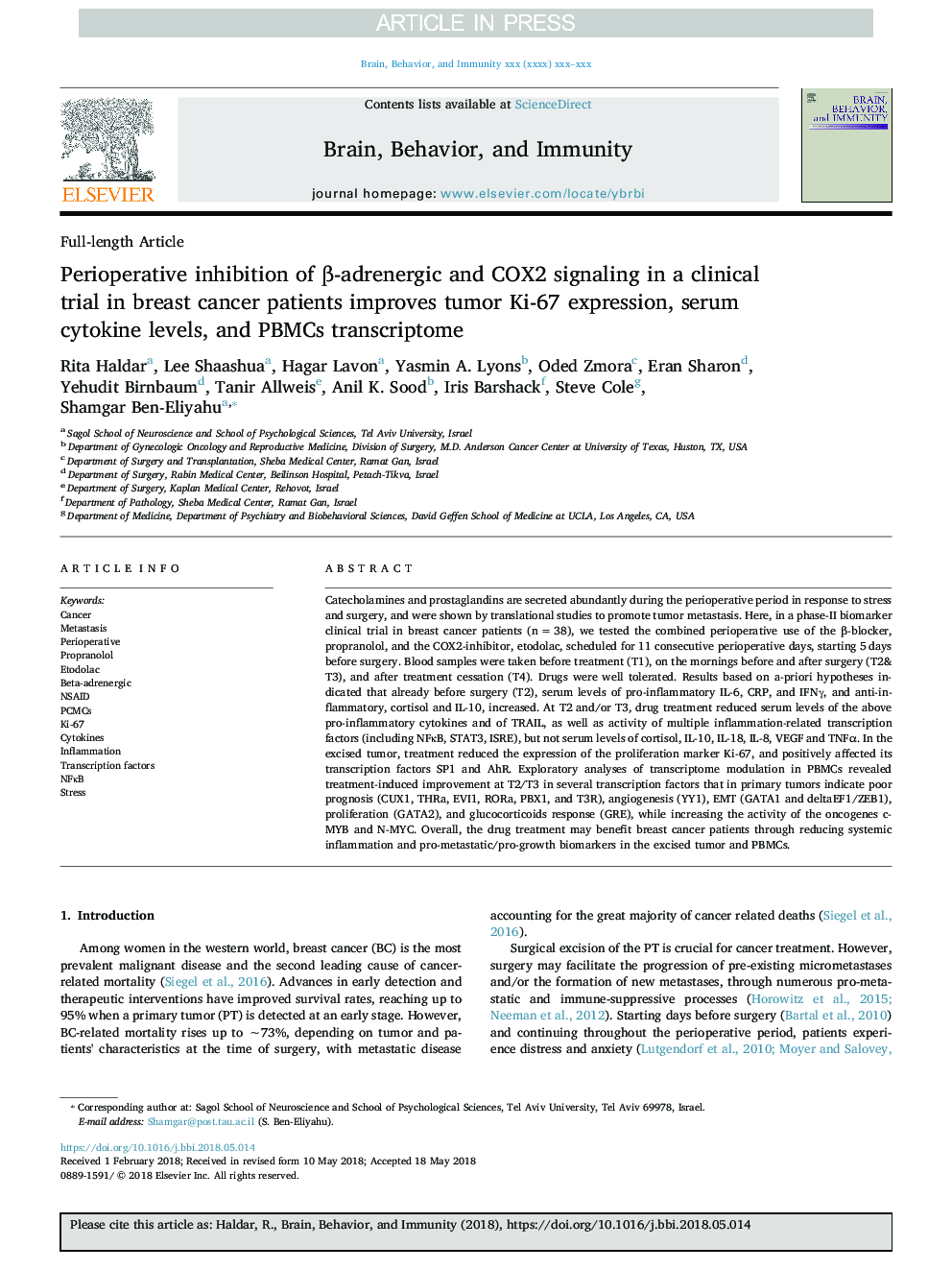| کد مقاله | کد نشریه | سال انتشار | مقاله انگلیسی | نسخه تمام متن |
|---|---|---|---|---|
| 8960742 | 1646430 | 2018 | 16 صفحه PDF | دانلود رایگان |
عنوان انگلیسی مقاله ISI
Perioperative inhibition of β-adrenergic and COX2 signaling in a clinical trial in breast cancer patients improves tumor Ki-67 expression, serum cytokine levels, and PBMCs transcriptome
دانلود مقاله + سفارش ترجمه
دانلود مقاله ISI انگلیسی
رایگان برای ایرانیان
کلمات کلیدی
موضوعات مرتبط
علوم زیستی و بیوفناوری
ایمنی شناسی و میکروب شناسی
ایمونولوژی
پیش نمایش صفحه اول مقاله

چکیده انگلیسی
Catecholamines and prostaglandins are secreted abundantly during the perioperative period in response to stress and surgery, and were shown by translational studies to promote tumor metastasis. Here, in a phase-II biomarker clinical trial in breast cancer patients (nâ¯=â¯38), we tested the combined perioperative use of the β-blocker, propranolol, and the COX2-inhibitor, etodolac, scheduled for 11 consecutive perioperative days, starting 5â¯days before surgery. Blood samples were taken before treatment (T1), on the mornings before and after surgery (T2&T3), and after treatment cessation (T4). Drugs were well tolerated. Results based on a-priori hypotheses indicated that already before surgery (T2), serum levels of pro-inflammatory IL-6, CRP, and IFNγ, and anti-inflammatory, cortisol and IL-10, increased. At T2 and/or T3, drug treatment reduced serum levels of the above pro-inflammatory cytokines and of TRAIL, as well as activity of multiple inflammation-related transcription factors (including NFκB, STAT3, ISRE), but not serum levels of cortisol, IL-10, IL-18, IL-8, VEGF and TNFα. In the excised tumor, treatment reduced the expression of the proliferation marker Ki-67, and positively affected its transcription factors SP1 and AhR. Exploratory analyses of transcriptome modulation in PBMCs revealed treatment-induced improvement at T2/T3 in several transcription factors that in primary tumors indicate poor prognosis (CUX1, THRa, EVI1, RORa, PBX1, and T3R), angiogenesis (YY1), EMT (GATA1 and deltaEF1/ZEB1), proliferation (GATA2), and glucocorticoids response (GRE), while increasing the activity of the oncogenes c-MYB and N-MYC. Overall, the drug treatment may benefit breast cancer patients through reducing systemic inflammation and pro-metastatic/pro-growth biomarkers in the excised tumor and PBMCs.
ناشر
Database: Elsevier - ScienceDirect (ساینس دایرکت)
Journal: Brain, Behavior, and Immunity - Volume 73, October 2018, Pages 294-309
Journal: Brain, Behavior, and Immunity - Volume 73, October 2018, Pages 294-309
نویسندگان
Rita Haldar, Lee Shaashua, Hagar Lavon, Yasmin A. Lyons, Oded Zmora, Eran Sharon, Yehudit Birnbaum, Tanir Allweis, Anil K. Sood, Iris Barshack, Steve Cole, Shamgar Ben-Eliyahu,